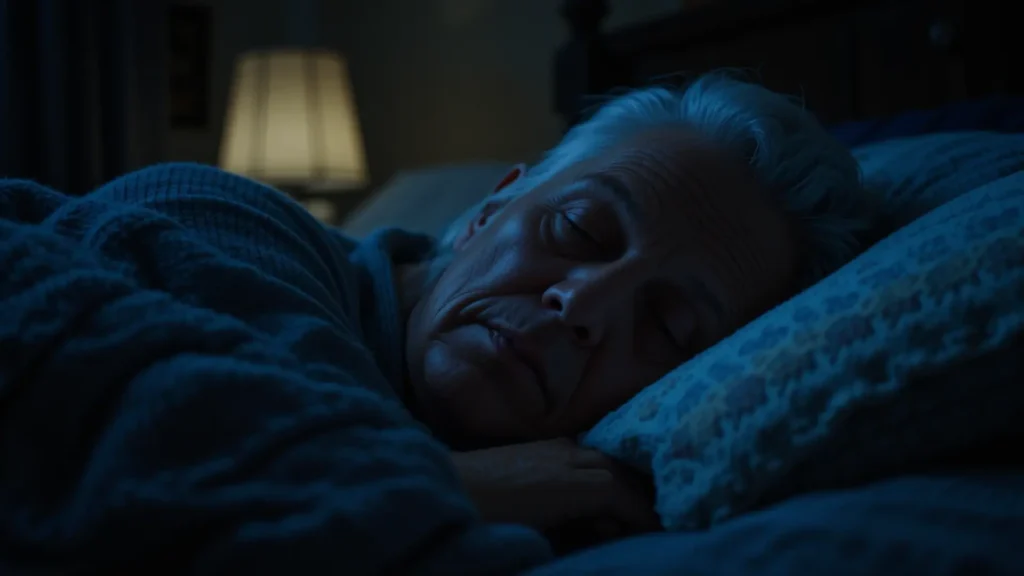Your bedroom can either help you rest—or keep you tense. Most seniors don’t realize how much the bedroom affects their mood, memory, and health.
Bad lighting, clutter, noise, or the wrong mattress can all raise your stress without you knowing it. But here’s the good news: you can fix it without much effort or cost.
Why a Calm Bedroom Is Not a Luxury—It’s a Need
Your brain becomes more sensitive with age. Sounds feel louder. Lights feel harsher. Sudden noise or light can wake you or keep you from falling asleep. A calm bedroom keeps those triggers away so your brain can finally rest.
Your body also slows down. It doesn’t shift from busy to relaxed as fast. If your room feels too hot, too cluttered, or too noisy, your body stays on high alert. A calm bedroom tells your system that it’s safe to let go.
Most seniors already have trouble sleeping. You may lie awake for hours or wake up too early. You may feel tired but still not fall asleep. These problems grow when the bedroom works against you instead of helping you.
Poor sleep affects more than just your mood. It slowly harms your memory. It weakens your immune system. It increases your chances of falling. Over time, it drains your energy and makes daily life harder.
Some seniors use sleep pills to try to fix the problem. But pills don’t fix loud TVs, streetlights, or piles of clutter. They don’t make your brain feel safe. And they can cause grogginess, falls, or confusion the next day. Adjusting the bedroom is safer and works better long term.
The good news is that the fixes are small. You don’t need to buy much or change everything at once. A different bulb, a softer sheet, or removing one noisy device can all help. These simple steps help your brain feel peace instead of pressure.
Your bedroom can become your healing zone. It’s the one place where your muscles can relax. Your joints can reset. Your heart rate can slow down. It’s where your brain can let go of the day and recharge for tomorrow.
Many people miss this connection. They blame age for poor sleep. They assume rest just gets worse with time. But your space plays a bigger role than you think. A calm bedroom helps your body and brain recover—and that changes everything.
Creating a Calm Bedroom for Older People
We’ll walk through how to build that kind of space—step by step.
Step 1: Fix the Light First
Light is not just something you see. It’s something your brain reads. When light is too bright or the wrong color at night, it tells your brain to stay awake. That blocks melatonin. Melatonin is the hormone that signals your body to sleep. Without it, deep rest doesn’t happen.
The first step is to check your bulbs. Look for warm, soft white bulbs. These are easier on the brain.
Avoid bulbs labeled “daylight” or “cool white.” Those have blue tones, and blue light tells your brain it’s still daytime.
Choose low-watt bulbs. You don’t need your room to be bright after sunset.
Next, change where the light comes from. Ceiling lights light up the whole room. That’s too much. Use table lamps or floor lamps instead. Keep the light low and soft in the evening. This helps the body start to wind down. It also feels more peaceful.
Now check your nighttime routine. If you get up to use the bathroom, you need just enough light to stay safe—not enough to wake your brain fully. Use a small night light in the hallway or bathroom. Pick one that shines downward or has a dim setting. Avoid lights that flash or change colors. Those disrupt your rest.
Windows matter too.
If streetlights shine into your room or if the sun wakes you up too early, your brain stays on high alert. Add blackout curtains to block outside light. Or wear a soft sleep mask. These tools help your brain stay in deep rest, even if the outside world doesn’t.
And during the day, let sunlight in.
Open the curtains or blinds when you wake up. Natural light tells your body that it’s morning. This helps set your sleep cycle. It keeps your mood steady and supports better sleep later.
A calm light setup gives your brain the signals it needs. It says: the day is over. It’s time to rest. This small change creates big results for better sleep and sharper mornings.
Step 2: Keep the Air Cool, Clean, and Quiet
Your room’s air and sound affect your body more than most people think. If the air is too hot, dry, or loud, your nervous system stays tense. That makes it hard to fall asleep. It also makes it hard to stay asleep.
Start with temperature.
The best range for most seniors is between 65 and 70 degrees Fahrenheit. If your room feels hot or stuffy, your body can’t cool down. That keeps your heart rate high and your sleep light.
Use a fan if needed.
It moves air around and cools your skin. But pick a fan that runs quietly. If it hums or rattles, it may disturb your rest instead of helping it.
Next, check the air itself. Is the room dry? Do you wake up with a dry mouth or nose? Dry air can bother your skin, lungs, and throat. If this happens, try a small humidifier. Or open a window for a few hours during the day.
Now think about air freshness.
Stale air feels heavy. It tells your body something is wrong, even if you don’t notice it. Keep your windows clean. Dust your fan blades. Let fresh air in when the weather allows. Clean, moving air supports deep sleep and easier breathing.
Sound is just as important.
Noise can interrupt your sleep without fully waking you up. That means your brain never gets full rest. Pay attention to sounds from outside your room. Are you near a busy street or loud hallway?
You have options. Use earplugs if outside noise is strong. Try a white noise machine to block sharp sounds. Some seniors find calm in soft sounds—rain, ocean waves, or gentle wind. These can help the brain focus and relax.
The goal is to remove anything that makes your brain stay alert. You want your bedroom to feel safe, steady, and silent. That’s what tells your nervous system to switch into repair mode.
Cool air. Clean flow. Quiet space. These things might seem small—but together, they create the kind of sleep your body needs to heal and recharge.
Step 3: Remove What Doesn’t Belong
This is where stress hides: in piles, in mess, in too many objects that don’t bring calm.
Look around your room. Do you see a stack of unpaid bills? Old newspapers? A noisy clock or blinking screen? Remove what pulls your brain in the wrong direction.
Keep surfaces clear. Put small bins inside drawers to keep things simple. Don’t keep exercise gear, unpaid paperwork, or electronics in the bedroom. This space is for rest, not for reminders or noise.
What about TVs? Many seniors watch shows in bed. But screens before sleep can keep your brain active.
If you keep a TV, set a sleep timer. Keep the volume low. Or use it earlier in the evening—not right before sleep.
This step is not about how the room looks. It’s about what the room does to your nervous system.
Too much clutter sends a signal: stay alert. That’s the opposite of calm.
Step 4: Make the Bed Feel Safe and Soothing
The bed should feel right the second you touch it. Not fancy. Just right.
Start with the mattress.
It should support your back, hips, and joints. If it sags or leaves you sore, replace it. If you can’t buy a new one, add a firm topper. Memory foam or pressure-relief pads help a lot.
Now check your sheets. Use soft cotton or bamboo. Avoid anything rough, stiff, or itchy. Wash them with unscented detergent. Strong smells can disrupt your brain at night.
Pillows matter too. They should hold your neck in line with your spine. Too high or too low can cause pain and tension. Test different pillow heights while lying down—not while sitting.
Add a weighted blanket if you tend to feel restless. Just be sure it’s not too heavy. Your goal is clear: your bed should feel safe, supportive, and gentle. That’s what tells your body it’s time to slow down.
Step 5: Use Simple Tools That Calm the Mind
Once your room is clean, cool, and quiet, you can take one more step. You can help your brain relax on purpose. This is not about big effort. It’s about small, gentle cues that tell your brain it’s safe to rest.
Let’s start with sound.
Soft sounds can calm the nervous system fast. Try a short sound routine you use only at bedtime. This could be gentle chimes, soft rain, a slow piano song, or waves. Pick one sound. Use it every night. Over time, your brain will link that sound with sleep.
Next, use scent—but safely.
Scents like lavender and chamomile help lower stress. They work through your nervous system without needing pills or effort. Use an oil diffuser with a timer. Let it run for 15 to 30 minutes. Never use candles at night. They can be dangerous if left burning while you sleep. Always choose safe, automatic tools.
Now create a short wind-down routine. Just five minutes can help. No screens. No talking. No eating. Sit or lie down. Breathe slowly. Count each breath if that helps you stay focused. Let your body feel heavier with each breath. That’s your nervous system slowing down.
Use a soft lamp during this time.
Big lights tell your brain to stay alert. Soft light says, “It’s time to let go.” Turn off overhead lights at least 30 minutes before sleep. Use the same soft light every night to build the habit.
The key here is consistency.
Your brain learns through patterns. When you repeat the same calm steps each night, your brain starts to respond faster. You’ll feel your heart slow down. You’ll feel your thoughts slow down. This is how deep sleep begins—by setting the stage with simple, clear steps.
These tools don’t need to cost much. You don’t need special skills or tech. You need regular, calming habits that happen every night. They signal to your brain: “You are safe. You are done for the day.” That’s when true rest begins.
Simple tools. Short routines. Safe signals. This is how seniors can train the brain to relax—without pills, stress, or confusion. And when the brain learns to rest, the body follows.
The Emotional Payoff: Why This All Works
1. Many Seniors Feel Out of Control: As you get older, some things change without your say. Your joints feel stiffer. Your memory may feel slower. Noise becomes more stressful. Sleep gets harder. These changes can feel frustrating. They can also make you feel powerless.
2. Your Bedroom Is One Thing You Can Control: You can’t change your age—but you can change your room. You control the lights. You control the sounds. You control what stays and what goes. That kind of control builds peace. It reminds you that you still have power over your space and your rest.
3. Every Small Fix Adds Up: One soft lamp. One cleared shelf. One gentle sound routine. Each small change makes your brain and body feel safer. And when you feel safer, you sleep better. You wake up with more clarity and calm.
4. A Calm Room Supports Your Health: Better sleep isn’t just about feeling rested. It helps your immune system stay strong. It improves your mood. It sharpens your focus. When your room helps you sleep deeply, your whole body works better the next day.
5. You Don’t Have to Fix Everything at Once: You don’t need to buy everything new. You don’t need a full makeover. Pick one thing to change: a new bulb, a cleaner nightstand, or better sheets. Start there. Try it for a few nights. Then see what happens.
6. The Real Win Is in What Your Brain Learns: The goal is not a perfect room. It’s a room that teaches your brain this message: “Bedtime means safety. This space is calm. You can let go.” When your brain trusts that message, sleep comes faster—and it runs deeper.
You don’t have to live with poor sleep. You don’t have to feel on edge at bedtime. And you don’t have to spend money on fancy gadgets.
Start by adjusting the light. Fix the air, the noise, and the temperature. Clear what doesn’t belong. Make the bed feel right. Add soft habits at night.
Don’t rush this. Pick one step each week. Build your calm bedroom slowly. Your body will notice. Your brain will too. And you’ll wake up to days that feel more grounded, more clear, and more calm—because your nights were.




